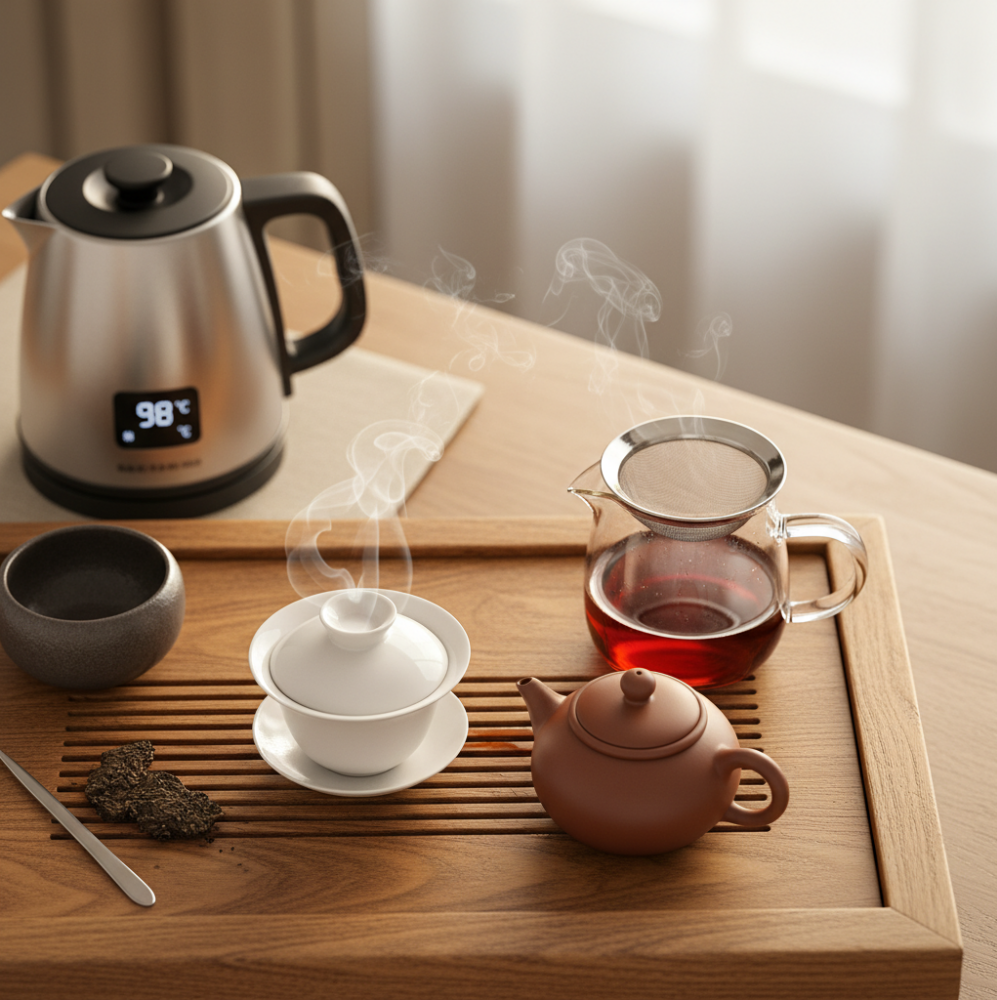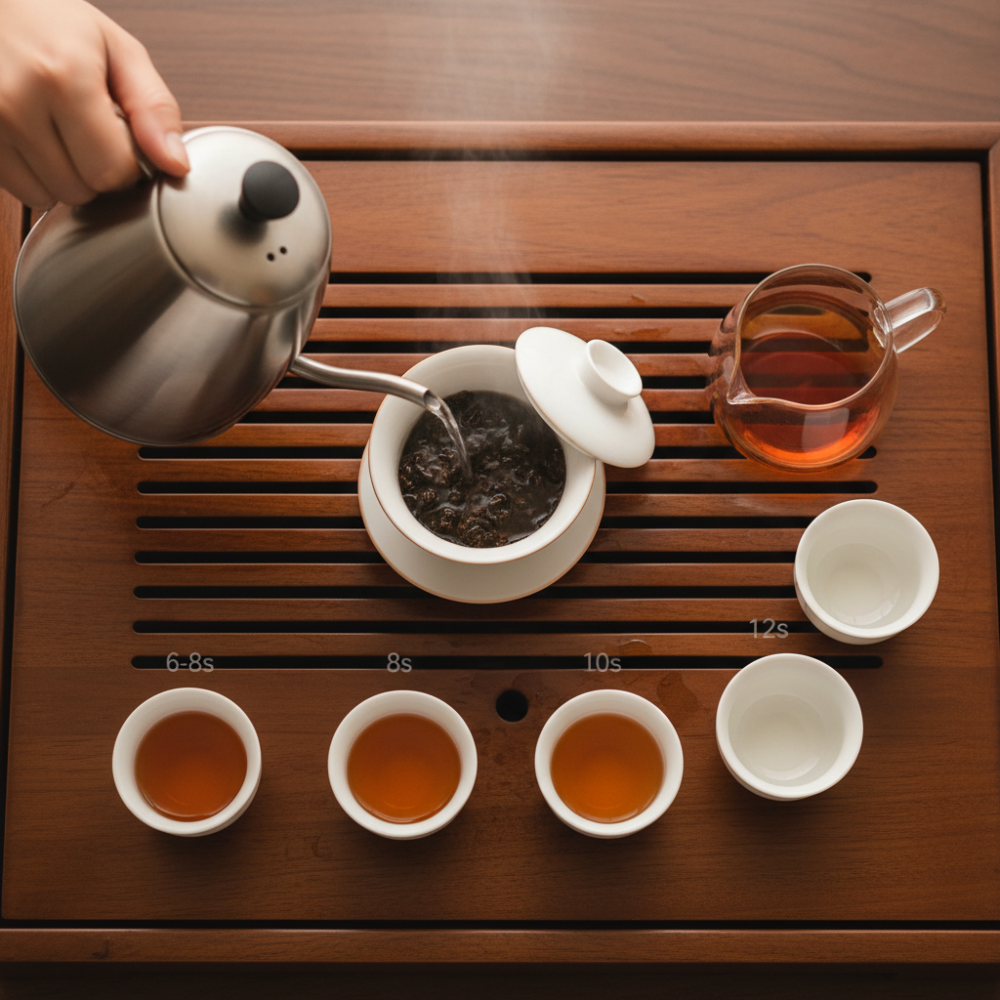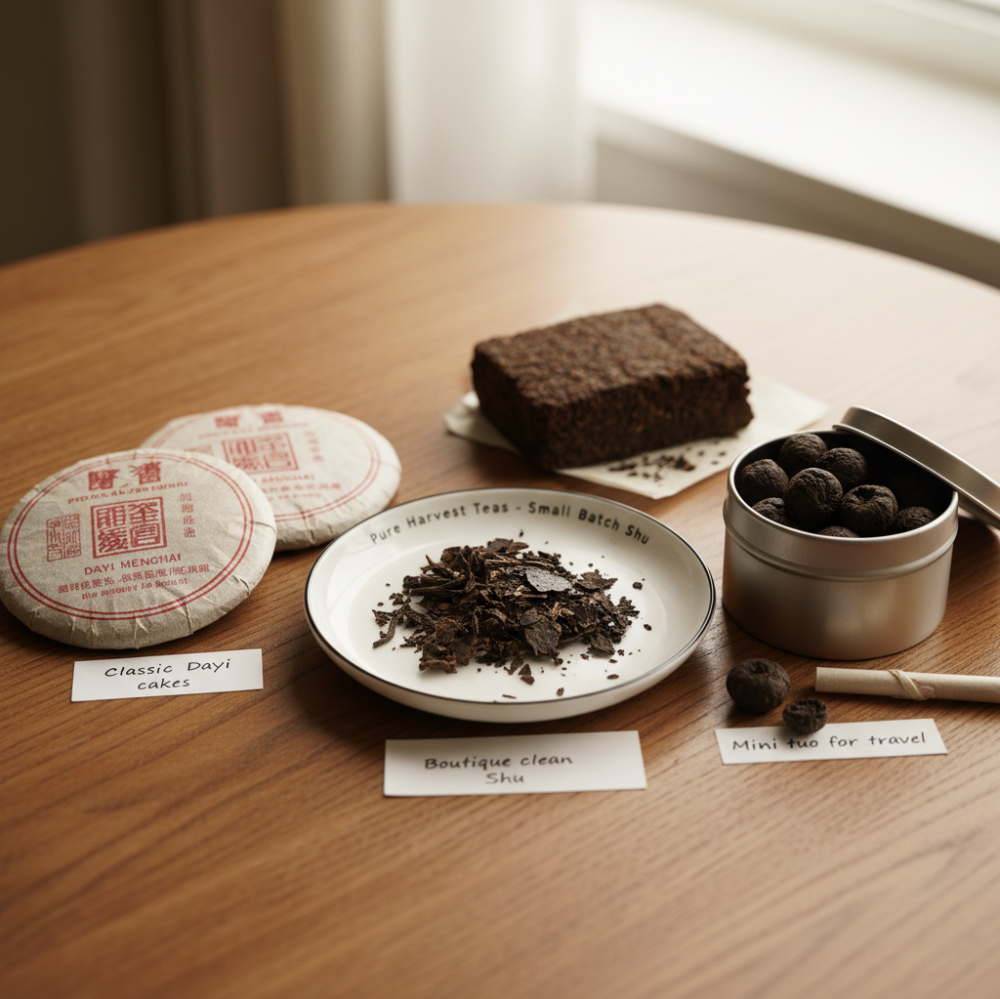Shu Pu’er (熟普洱), sometimes called “ripe” or “cooked” Pu’er, has an earthy depth that’s all its own. If you’re coming from the raw (Sheng) Pu’er world, you’ll notice the difference instantly—the smoothness, the rich flavors, and the way Shu seems to offer comfort with every cup. While Sheng grabs your attention with its energy and tang, Shu is mellow, grounding, and perfect for unwinding.

Brewing Shu Gongfu style is super rewarding, and dialing in your technique can reveal loads of subtle flavors many folks miss by tossing it in a mug. This guide is for anyone who’s read my Sheng Pu’er Gongfu how-to (worth checking out if you haven’t yet!) and wants to complete the experience by mastering both sides of Pu’er tea brewing.
What Makes Shu Pu’er Unique
Shu Pu’er is all about the wet-piling fermentation process, called “wo dui.” The fresh tea (called Mao Cha) is carefully stacked in manageable piles, sprayed with water, and kept warm under covers. Over 45 to 60 days, beneficial microbes do their work, breaking down the leaves and transforming their color, aroma, and flavor. This process is the magic behind Shu’s signature dark liquor and earthy, sometimes chocolaty, aroma.
I’ve definitely noticed some Shu batches come out squeaky clean with notes of wood and cream, while others have a bit of that infamous “wo dui” funk. Think pond or fish-tank smell. That’s not necessarily a flaw, but most drinkers prefer clean-tasting Shu. Young Shu can be a little bolder and sometimes has that fermentation edge, but as it ages, those rough corners turn into smooth, rich sweetness.
You’ll also find Shu Pu’er shaped into cakes (bing), bricks (zhuan), tiny birds’ nests (mini tuo), and even loose-leaf or “scatter” (san cha). Each format offers a slightly different brewing experience, and Gongfu style really lets the unique creamy, thick mouthfeel of Shu shine in a way Western-style teapots just can’t deliver.
Essential Tools for Brewing Shu Pu’er Gongfu Style

The right tools make a huge difference when it comes to Gongfu brewing. Here’s what I always reach for when prepping a Shu Pu’er session:
Gaiwan or Yixing Clay Teapot: For maximum flavor clarity, a porcelain gaiwan is hard to beat, but a well-seasoned Yixing teapot can bring extra smoothness and body to Shu.
Kettle with Temperature Control: Keeping your water near boiling is really important for Shu. Smart kettles help keep things steady. I did a full smart-kettle review if you want to dig into options.
Strainer, Fairness Pitcher, or Cha Hai: Shu often has small particles, so I use a mesh strainer over a glass fairness pitcher to keep my cup clear and avoid extra bitterness.
Tea Pick or Knife: Super handy for breaking cakes or bricks cleanly.
Tea Tray and Catch Bowl: Optional but great for Gongfu sessions; makes cleanup easier since you’ll be pouring off many short steeps.
If you’re brand new to Gongfu, my Gongfu brewing guide covers these tools in more depth too.
Recommended Tea-to-Water Ratio
Getting the right balance of tea to water is the first thing I adjust when exploring a new Shu. The classic starting point is 5 grams of dry leaf per 100ml of water. That ratio works well for most compressed cakes and loose-leaf. If you’re using tightly compressed cakes, especially with some age, it helps to go slightly heavier (maybe 6 grams or a few extra leaves) since they take longer to unfurl.
Mini tuo (tiny bird’s nest) are often 4-6 grams each, which just about matches the 100ml starting point. Convenient for travel or quick sessions. When brewing larger bricks or densely packed cakes, break off manageable chunks so the leaves aren’t too compacted, and increase your dose just a hair to help them open up in early steeps.
Shu can be really forgiving if you misjudge the amount slightly, but nailing the ratio is the difference between a luxuriously thick body and a dull, over-brewed mess.
Water Temperature for Shu Pu’er Gongfu Brewing
98-100 °C (208-212 °F) is ideal for brewing Shu Pu’er Gongfu style. The near-boiling temperature quickly wakes up those tightly packed leaves and gets the fermentation flavors moving. Cooler water (below 95 °C / 203 °F) tends to mute the richness and “body” of Shu, leaving you with a flat or slightly muddy cup.
Modern electric kettles with temperature settings make this super easy. I always pre-boil, open the lid, and let the roaring steam fade just a bit before pouring. This way you avoid scalding but keep the water hot enough to penetrate and unlock all that flavor. If you’re brewing over a long session, a smart kettle on hold is super useful for keeping things on track.
The Rinse: One or Two Rinses for Shu Pu’er?
Shu Pu’er needs at least one quick rinse, often two. The wet-piling process leaves behind a bit of dust and extra small particles. The rinse (or “wake-up”) step softens the leaves, helps shed that dust, and gets rid of any unpleasant storage notes.
For most newish or factory Shu, I do two fast rinses (5 seconds each). This clears any residual odors and gets the leaves blooming nicely. If you’re working with an older (10+ years) or very high-quality clean Shu, one rinse is usually enough. If the aroma is appealing and the rinse liquor is already clear, go ahead and start drinking. Strong “pile” aroma or cloudiness after one rinse means a second is a good idea.
Step-by-Step Gongfu Brewing Instructions for Shu Pu’er

From my own sessions, I’ve found a simple, mindful routine really brings out the best in Shu. Here’s what usually works for me:
Heat your Teaware: Pour boiling water into your gaiwan or teapot, fairness pitcher, and cups. Swirl, then dump the water. Hot teaware keeps those first few infusions strong and steady.
Add the Tea: 5 grams per 100ml as mentioned earlier. For bricks or cakes, break off a little extra if they’re super dense.
Rinse (Once or Twice): Cover leaves with boiling water, swirl, then pour off immediately. Repeat if necessary. The rinse can also help you judge quality. If it smells dank or fishy, give it another quick rinse.
Brewing the First Infusion: Fast and hot, 6 to 8 seconds. Pour water vigorously to help the leaves open up, then pour off completely. Serve right away.
Subsequent Steeps: I typically go:
2nd: 8 seconds 3rd: 10 seconds 4th: 12 seconds
Add about 2 seconds to each brew after that.
By the fourth steep, Shu usually turns sweet, thick, and creamy. That’s when I can really tell if the batch is a keeper.
Sessions often run 10-15 infusions, especially for high-quality Shu. If the flavor weakens, bump up the timing by 5 seconds or do a slow pour. During a real session last week, I got twelve infusions out of a 2012 Dayi cake before it finally lost its glow. I usually save my leaves for one cold-brew batch overnight to squeeze out even more sweetness.
How to Identify Good Shu vs Poor Shu
Quality Shu starts with the aroma: clean, earthy, and sometimes a little woody or creamy. If you get a fishy or swampy aroma right out of the wrapper, it might mean a rough “wo dui” process or poor storage. Don’t write it off immediately, though, as a few steeps can mellow those off notes.
Mouthfeel: Great Shu should feel creamy and smooth on the tongue. If it’s chalky, dusty, or makes your mouth feel dry, it’s often a sign of over-fermentation or bad aging.
Sweetness: After several brews, a good Shu goes from earthy to sweet and round. If it’s flat, bitter, or never develops richness, it’s usually factory-grade or poorly fermented tea.
Analysis During a Session: Don’t toss out a funky Shu after a single steep. Some Shu starts rough and blossoms after 4 or 5 infusions, shedding harsh notes and turning super drinkable. Small-scale and newer producers have improved the “clean” standards a lot in the past decade, so boutique Shu is worth exploring.
Advanced Techniques for Shu Pu’er Gongfu Brewing
I’ve learned a handful of tricks from years of brewing Pu’er that really get the best from Shu:
Breaking Compressed Leaves: Use a tea pick to pry gently along the layers; work sideways instead of stabbing down to reduce tea dust and broken leaf. Don’t rush, as patience means better flavor and fewer bits in your cup.
Using a Yixing Teapot: Dedicated Yixing clay (especially zini or hongni) brings extra heft and creaminess. Reserve one pot for Shu only, since flavors stick around in clay. I keep one for classic Dayi blends and another for boutique clean Shu.
Mini Tuo Gongfu: These tiny nests often need a minute or two to start opening. Use a slightly higher water-to-leaf ratio or do an extra rinse to help loosen up the compact ball.
Smart Kettles for Long Sessions: Keeping water steaming hot through 12 or more steeps is tough. I use a smart kettle with a “hold” feature to keep things right at 98-100°C so every infusion can extract properly, especially when sharing tea with friends.
Cold Brewing Leftover Shu: After your session, toss spent leaves in a cold-water bottle and fridge overnight. The next day, you’ll get a surprisingly sweet, caramel-like cold brew without any bitterness.
Troubleshooting Shu Pu’er Gongfu Brewing
If you’re getting a muddy taste, try using two quick rinses and straining well. A gaiwan or glassware can provide better clarity if a Yixing pot seems to dull the flavors. Using filtered water helps too, and you might want to decrease your tea dose if the brew is thick like soup.
Weak flavor usually means you need to add more leaf, increase water temperature, or extend steeping time. Breaking compressed chunks into smaller pieces helps them unfurl more easily in the early steeps.
Some cloudiness is normal in early steeps, especially for very fresh or loose-leaf Shu. Two rinses and a proper mesh strainer should help clear things up if cloudiness is excessive.
If flavor is fading after just a few brews, try extending steep times by 5 or 10 seconds per infusion, or combine two infusions into one. Make sure you’re using hotter water and that the leaves aren’t getting cold between steeps.
Best Shu Pu’er Types for Beginners

If you’re just getting started, certain Shu Pu’er teas make the process way easier and a lot more fun. Here are my go-to recommendations for beginners:
Classic Dayi (Menghai) 7572 or 7262: These recipes are industry standards: smooth, reliable, and very easy to brew Gongfu style. Find Dayi cakes on Amazon or tea specialist shops.
Modern Boutique Clean Shu: Vendors like Yunnan Sourcing or White2Tea stock small-batch Shu with minimal fermentation funk. I find these are friendlier if you’re sensitive to strong earthy flavors.
Mini Tuo for Travel: Great for on-the-go, these single-serving pieces make packing easy. Avoid ones that look white or dusty (too much surface yeast or mold risk).
For first-timers, avoid super cheap factory bricks or “unknown origin” teas, as these are more likely to taste fishy or metallic. Reading reviews and buying from trusted sources helps a lot; careful research helps buyers make informed decisions.
Shu Pu’er Gongfu Tea FAQ
Why does my Shu taste fishy?
Usually it’s leftover fermentation odors from the wet-piling. Two quick rinses and a few extra infusions will mellow most of it. Some newer batches just need time to air out.
Can I brew Shu Pu’er in a gaiwan?
Absolutely. Gaiwans give you the most control and the clearest flavors, especially for new batches you’re evaluating for the first time.
Is Shu Pu’er caffeinated?
Yes, Shu contains caffeine, usually a bit less than fresh Sheng or green tea, but enough to give a gentle energy boost. It’s perfect for afternoons and evenings if you don’t mind a mellow lift.
How long should I let Shu Pu’er age?
Most Shu is drinkable right away, but aging for 3 to 5 years can improve sweetness and remove rough notes. Very high-end Shu can age for a decade or more, turning syrupy and ultra-smooth.
Why are my steeps turning bitter?
Brewing too long or using too much leaf can bring out bitterness. Adjust your time, or try cooler water and see if it softens the flavor.
How many steeps can Shu Pu’er produce?
With Gongfu style and good leaf, a session can go 10-15 infusions (sometimes more with high-end tea). As the flavor fades, try cold brewing the leaves to finish up.
Extra Thoughts for the Gongfu Curious

If you’ve brewed through both Sheng and Shu guides, treat yourself to a side-by-side tasting sometime. It’s wild how different the spectrum can be even with the same region or producer. Check out my other Gongfu tea tutorials for more hands-on advice, browse my smart-kettle reviews for gadgets that streamline the process, or dig into my Gongfu beginner’s toolkit to gear up with confidence.
There’s a ton you can explore once you get the basics down, and if you have questions, I love hearing from fellow tea nerds too. Here’s an extra tip: for anyone exploring tea further, journaling your sessions can really help you spot patterns and track your own taste preferences as you get more experienced with Shu. Happy sipping!
Here’s a little transparency: Our website contains affiliate links. This means if you click and make a purchase, we may receive a small commission. Don’t worry, there’s no extra cost to you. It’s a simple way you can support our mission to bring you quality content.

Chris is the founder of Zen Tea Tools and a passionate explorer of traditional and modern tea brewing. From Gongfu sessions to smart tea technology, he shares practical insights to help others find clarity, calm, and better tea.Learn more about Chris →
Leave a Reply